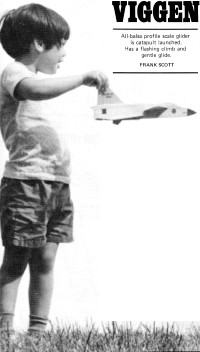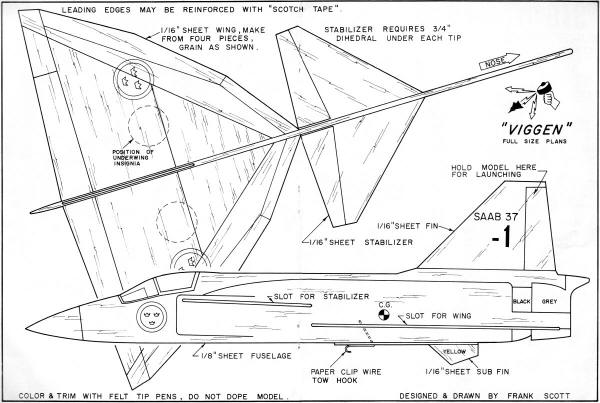|
For some reason I never did much
with catapult gliders. The ones you used to be able to buy in the convenience store for
a quarter or so were pretty good, but after a few hard landings you had to glue the balsa
wing halves into the plastic holders. The ones we bought had the wing halves on a pivot
that allowed the wings to fold up during the high speed launch and then a small rubber
band pulled them back down at the apogee. None of them lasted more than a few flying
sessions. This Viggen model has fixed wings and probably performs a lot better than those
dime store models.
Airplanes and Rockets Forum poster Jaegee63 asked me to post this article. See the
article "Thor's New Hammer - the Saab A37
Viggen" for information on the full-scale aircraft.
Viggen: All-balsa profile scale glider is catapult launched. Has a flashing climb
and gentle glide.
Frank Scott
 Viggen: The three-forked thunder-bolt from the hammer
of Thor. Viggen is also the amazing new fighter for the defense of Sweden. Viggen: The three-forked thunder-bolt from the hammer
of Thor. Viggen is also the amazing new fighter for the defense of Sweden.
Built by Svenska Aeroplan AB, better known to us as SAAB, the Viggen possesses Mach
2 performance yet will not rely on vulnerable airfields. It is as versatile as our own
Phantom and will undertake attack, reconnaissance, and all weather intercept roles. All
of this, yet it only needs a 1500-ft. runway, or highway, for its operations.
Our model has the flashing climb of the original, yet is quite easily built with little
expense.
Construction
Begin by covering your work table with a piece of Saran Wrap so the glue won't stick
where it shouldn't; glue the 1/16" sheet balsa wing pieces together flat as there is
no dihedral or curved airfoil. While the wing dries, cut out the fuselage from a firm
piece of 1/8" balsa. Round the edges with sandpaper and glue the 1/16" sheet balsa fin
and sub fin in place.
The wing should be dry now; sand it smooth and round the edges with fine sandpaper.
The canard stabilizer, or foreplane if you will, is cut from 1/16" sheet balsa and
sanded. Cut it apart at the center and glue back together propping up each stabilizer
tip 3/4" for the necessary dihedral.
You will find that it is much easier to decorate the model at this point than after
it is assembled; therefore mark out all desired control surface outlines and panel lines
with fine pointed felt tipped marking pens or ballpoint pen. Well-stocked hobby shops
may have Swedish decals, but if not, make your own insignia on plain white paper with
colored ink or pen, then cut out and glue in place.
To assemble the model it is only necessary to slide the stabilizer and wing into their
proper slots and glue very securely. Make sure the parts are carefully aligned before
the glue dries.
Bend the launching hook from a paper clip, shove the end into the wood of the fuselage,
and glue very securely to complete the model. It is important to locate the hook as shown
on the plan.
Flying
Now that you're ready to fly the Viggen, check to see that your model balances at
the location shown on the plan. No ballast has been necessary on our Viggens, but if
yours does not balance correctly, add bits of clay to nose or tail as required.
Hand glide your model to check for proper flight, correct turning with bits of clay
on the high wing and do not warp the surfaces for adjustments, as the higher speeds during
launch can cause over control and subsequent surprises.
Prepare the hi-start launcher with a ten-ft. length of 1/8" flat rubber tied at one
end to a stick driven into the ground and with a 30- or 40-ft. length of string at the
other end. A paper clip may be tied at the remaining end of the string to complete the
catapult.
Now it's launch time. Slip the paper clip over the hook in the model and draw the
rubber taut. Face the Viggen into the wind and if you grasp the model by the upper rear
corner of the fin it will automatically come to the proper angle for a smooth, high launch.
If the model tries to loop as it comes off the towing line, simply add more string
to the towline until the model comes off in a flat glide. If the model stalls in the
glide and flutters down without recovering, add a bit of weight to the nose and possibly
bend the trailing edge of the stabilizer down to prevent diving. Note that the action
of the elevators on a canard model is opposite that of the conventional airplane.
Have fun with your Viggen, and with a bit of turn in the glide you should have no
trouble flying in a field the size of the average school yard.
Material List
One 1/16 x 3 x 36" sheet balsa (flying surfaces); one 1/8 x 2 x 18" sheet balsa (fuselage);
two paper clips; model cement; felt marking pens and decals as required; ten ft. 1/8"
flat rubber and string for catapult.

<click for larger version>
Full-size wingspan is 10" exactly.
The plans originally were printed on
the center two pages and were removed and flattened for the scan.
Notice:
The AMA Plans Service offers a
full-size version of many of the plans show here at a very reasonable cost. They
will scale the plans any size for you. It is always best to buy printed plans because
my scanner versions often have distortions that can cause parts to fit poorly. Purchasing
plans also help to support the operation of the
Academy of Model Aeronautics - the #1
advocate for model aviation throughout the world. If the AMA no longer has this
plan on file, I will be glad to send you my higher resolution version.
Try my Scale Calculator for
Model Airplane Plans.
Posted March 22, 2012
|